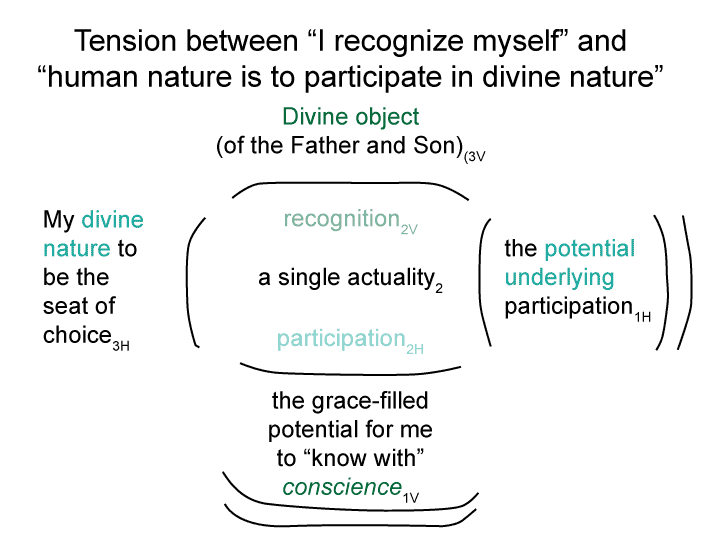Man and Sin by Piet Schoonenberg (1964) 2.2A
Summary of text [comment] page 70
Schoonenberg wrote that sin is the opposite of love. Sin, in its fullness, is a loss of the life of grace, hence it excludes supernatural love. The unity of nature [disposition] and grace [person, conscience] also means that sin excludes human natural love.
Natural love always welcomes the offer of grace and is assumed into supernatural love.
[How to appreciate this? Perhaps the intersection of recognition and participation affords the model.]
Man and Sin by Piet Schoonenberg (1964) 2.1FJ
Summary of text [comment] pages 69 through 71
Thus, Schoonenberg concluded section 1 (Sin Itself as Punishment), of chapter 2, (The Sequels of Sin).
[Perhaps, self-destruction starts with the way the person recognizes “herself”. Yet, this process trains one’s nature as well.
Or maybe self-destruction starts with a change in human habits and dispositions. Then, this change alters conscience.
Both conscience and dispositions are required for ‘the state of grace’ as well as ‘the state of self-destruction’.
Both conscience and dispositions belong to the realm of possibility. They are often hard to distinguish. They may be distinct but they are inseparable. The realm of possibility is monadic.
Consequently, it is no surprise that, after Schoonenberg emphasized the influence of grace on the person, he immediately turned to a discussion of one particular effect of sin on our nature: the inability to love.]
Man and Sin by Piet Schoonenberg (1964) 2.1FI
[Art becomes important.
Art depicts the intersection in a way that any attempt at measurement cannot.
Roads cross at an intersection.]
Man and Sin by Piet Schoonenberg (1964) 2.1FH-3
Summary of text [comment] pages 69 through 71
[With the intersection of recognition and participation, one sees how ‘grace can manifest itself in the realm of actuality’. ‘The state of grace’ and ‘the state of self-destruction’ occur in a field of contradictions. Within this field, God may directly act. So may Satan.
However, the act cannot be measured.
Any instrument of measurement automatically introduces an alternate normal context that imposes on the actuality at hand.
It is impossible to measure how grace or self-destruction act.
Yet, it is not difficult to see the theodrama (that Schoonenberg describes) plays out.]
Man and Sin by Piet Schoonenberg (1964) 2.1FH-2
[The idol substitutes for God, but it cannot fully exclude the Father and the Son.
If the idol could exclude God, the tension between recognition and participation would collapse and the person would become demonic. Some call it ‘possession’.
In this example, God’s action merely heightens the drunk’s awareness of ‘how the booze has messed ‘him’ up and how awful ‘his’ body feels’.
“What,” the drunk may ask “himself”, “am I doing to myself?”
This question contradicts the recognition of his idol.
Furthermore, this question undermines the exclusivity of the normal context contextualizing the single actuality of recognition and participation.]
Man and Sin by Piet Schoonenberg (1964) 2.1FH-1
Summary of text [comment] pages 69 through 71
[The vertical axis comes into play as ‘self-destruction manifests itself in the realm of actuality’.
‘The state of self-destruction’ is contextualized by a divine object3V. This idol substitutes for God. ‘Getting drunk’ is this person’s way of ‘getting in touch with his idol’. The phrase, ‘drowning one’s sorrows’, points to ‘his’ conscience, his potential for ‘knowing with the idol’.]
Man and Sin by Piet Schoonenberg (1964) 2.1FG
Summary of text [comment] pages 69 through 71
[Let me attempt another example.
After meeting failure, a person drinks way too much vodka.
Here, the potion is vodka and the state of existence is self-destruction.
The normal context for the single actuality is despair. ‘The potential welling in response’ is ‘drowning in sorrow’.
Alcohol enters the bloodstream.
The drinker’s dispositions are the first to register the effect. “His” divinely appointed natural volition starts to slip. “His” ability to think changes.
The alterations of the horizontal axis are hidden. They just happen. “He” gets drunk.
That is how far “his” awareness of the horizontal axis goes.]
Man and Sin by Piet Schoonenberg (1964) 2.1FF
Summary of text [comment] pages 69 through 71
[I am working with the intersection of recognition and participation (2.1 DJ, DL and DN).
‘The state of having take a potion’ seems comparable to ‘the state of grace’ or ‘the state of self-destruction’.
Furthermore, the potion is taken in a content-level normal context in order to actualize certain possibilities.
The action of the potion directly alters the horizontal axis, pertaining to the divine nature and human nature.
Then, the transformed horizontal axis indirectly alters the vertical axis.]
Man and Sin by Piet Schoonenberg (1964) 2.1FE
Summary of text [comment] pages 69 through 71
By arguing that grace does not directly determine the dispositions, Schoonenberg emphasized personal responsibility.
[The conscience leads to ‘states of existence’ that may alter the dispositions.
The dispositions support ‘states of existence’ that may alter the conscience.]

